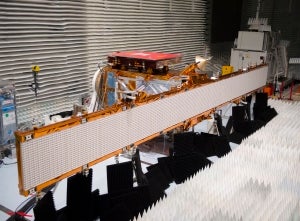
The SENER engineering and technology group is present in Copernicus, the European Earth observation programme led by the European Commission in collaboration with the European Space Agency (ESA). In particular, SENER provides technology in the Sentinel-1, Sentinel-2, Sentinel-3 and Sentinel-5 programmes.
In Sentinel-1, SENER is responsible for the deployment mechanisms for the four panels of the Synthetic Aperture Radar (SAR) antenna, which has nominally worked in orbit in Sentinel-1A after its launch in April 2014.
Sentinel-1B will be launched on 22 April and incorporates the same deployment system that will ensure that the radar collecting the mission data is properly deployed, which is key for the radar operation. In fact, the antenna, with a length of 12 metres, must be completely flat, with a relief variation not exceeding 1mm, and SENER’s technology will be responsible for this complex task.
SENER’s deployment system includes four mechanisms that incorporate the SENER actuator, known as Harmonic Drive Rotary Actuator (HDRA), which is the same that was successfully used in the deployment of the sunshield for the Gaia satellite. As in Sentinel-1A, the deployment of the four panels, each with a weight close to 200kg, will be sequential.
Recently, SENER announced its participation in Copernicus C and D Phases, and, therefore, the company will provide this same equipment to the future probes Sentinel-1C and Sentinel-1D.
Today, SENER is the main supplier for ESA in deployable booms. With nearly 50 years of experience as an engineering and production services supplier for the space industry, SENER has delivered successfully more than 270 devices and systems for satellites and space vehicles to agencies in the USA (NASA), Europe (ESA), Japan (JAXA) and Russia (Roscosmos).

